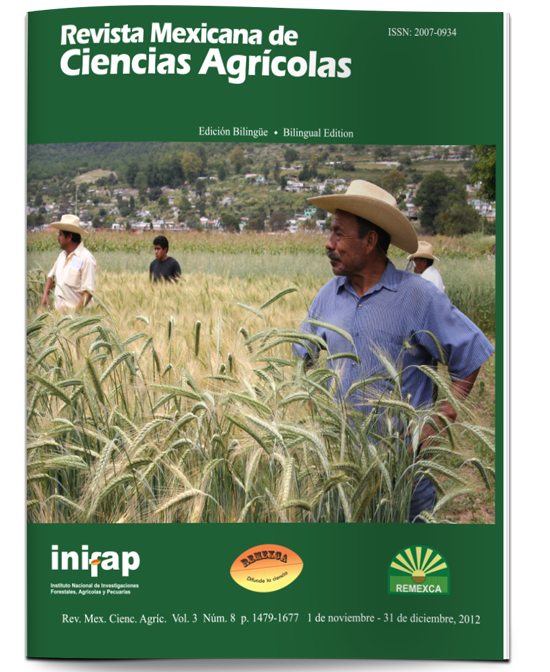Reference evapotranspiration estimated by Penman-Monteith-Fao, Priestley-Taylor, Hargreaves and ANN
DOI:
https://doi.org/10.29312/remexca.v3i8.1319Keywords:
Math lab, estimation, forecast, irrigation, weather variablesAbstract
The irrigation water is a requirement of crops and is based on the estimation of reference evapotranspiration (ETo) of each particular area, are subject to the limitation of existing meteorological data. The objective was to calculate ETo with FAO-Penman-Monteith (FAO-PM), Hargreaves (H), Priestly-Taylor (PT) and artificial neural networks (ANN). We used data from the weather station of Chapingo for the period 2003-2009. In the H and PT methods, four climatic variables were used for their calculation and in ANN were constructed different scenarios to evaluate the performance of the network, by changing the input climatic variables and the number of neurons in the hidden layer. The results of the coefficient of determination (r2) and root mean square error (RMSE) of H and PT are: 0.5378, 0.8553 and 0.6977, 0.6501 respectively. For ANN was found that with the largest number of variables and neurons in the hidden layer was obtained an r2 0.9986, and RMSE 0.0297 and in the scenario with the least number of variables and neurons in the hidden layer were 0.7549 and 0.5555. If you count with all the climatic variables ANN is better because the RMSE results are close to zero and its r2 approaches to one. If ANN decreases the number of neurons in the hidden layer and the variables, gives the greatest error estimate of ETo, but lower than those obtained by H and PT.
Downloads
Downloads
Published
How to Cite
Issue
Section
License
The authors who publish in Revista Mexicana de Ciencias Agrícolas accept the following conditions:
In accordance with copyright laws, Revista Mexicana de Ciencias Agrícolas recognizes and respects the authors’ moral right and ownership of property rights which will be transferred to the journal for dissemination in open access. Invariably, all the authors have to sign a letter of transfer of property rights and of originality of the article to Instituto Nacional de Investigaciones Forestales, Agrícolas y Pecuarias (INIFAP) [National Institute of Forestry, Agricultural and Livestock Research]. The author(s) must pay a fee for the reception of articles before proceeding to editorial review.
All the texts published by Revista Mexicana de Ciencias Agrícolas —with no exception— are distributed under a Creative Commons License Attribution-NonCommercial 4.0 International (CC BY-NC 4.0), which allows third parties to use the publication as long as the work’s authorship and its first publication in this journal are mentioned.
The author(s) can enter into independent and additional contractual agreements for the nonexclusive distribution of the version of the article published in Revista Mexicana de Ciencias Agrícolas (for example include it into an institutional repository or publish it in a book) as long as it is clearly and explicitly indicated that the work was published for the first time in Revista Mexicana de Ciencias Agrícolas.
For all the above, the authors shall send the Letter-transfer of Property Rights for the first publication duly filled in and signed by the author(s). This form must be sent as a PDF file to: revista_atm@yahoo.com.mx; cienciasagricola@inifap.gob.mx; remexca2017@gmail.
This work is licensed under a Creative Commons Attribution-Noncommercial 4.0 International license.



